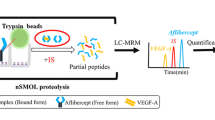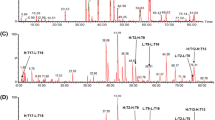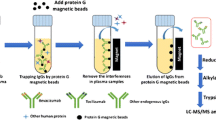Abstract
Ranibizumab is an FDA-approved drug used to treat wet age-related macular degeneration (AMD), diabetic retinopathy, macular edema, and myopic choroidal neovascularization. Bevacizumab is another drug often used off-label to treat wet AMD. In order to reduce unwanted angiogenesis, ranibizumab and bevacizumab target circulating VEGF-A in the eye. Concentration levels in human vitreous and aqueous humor can be used to provide valuable efficacy information. However, vitreous and aqueous humor’s aqueous environment, and vitreous humor’s viscosity, as well as the stickiness of the analytes can provide bioanalytical challenges. In this manuscript, we describe the development, optimization, and fit-for-purpose validation of an LC-HRMS method designed for intact quantitative bioanalysis of ranibizumab and bevacizumab in human vitreous and aqueous humor following intravitreal administration. In order to fully develop this method, evaluations were conducted to optimize the conditions, including the data processing model (extracted ion chromatograms (XICs) vs deconvolution), carryover mitigation, sample preparation scheme optimization for surrogate and primary matrices, use of internal standard/immunocapture/deglycosylation, and optimization of the extraction and dilution procedure, as well as optimization of the liquid chromatography and mass spectrometry conditions. Once the method was fully optimized, a fit-for-purpose validation was conducted, including matrix parallelism, with a linear calibration range of 10 to 200 µg/mL. The development of this intact quantitative method using LC-HRMS provides a proof-of-concept template for challenging, but valuable new and exciting bioanalytical techniques.



Similar content being viewed by others
References
Griffiths RA, Konijnenberg A, Viner R, Cooper HJ. Direct mass spectrometry analysis of protein complexes and intact proteins up to >70 kDa from tissue. Anal Chem (Washington). 2019;91(11):6962–6. https://doi.org/10.1021/acs.analchem.9b00971.
Samonig M, Huber C, Scheffler K. LC / MS Analysis of the monoclonal antibody rituximab using the Q exactive benchtop orbitrap mass spectrometer. Thermo Scientific Bulletin. 2016;(591):1–12. Retrieved from https://assets.thermofisher.com/TFS-Assets/CMD/Application-Notes/AN-591-LC-MS-Q-Exactive-Orbitrap-mAb-Rituximab-AN63918-EN.pdf. Accessed 15 April 2019.
Tingting Z, Zhenyu D, Qun X, Rohrer J. High-resolution separation of a fusion protein. Thermo Scientific Bulletin. 2016; 6–8. Retrieved from https://assets.thermofisher.com/TFS-Assets/CMD/Application-Notes/AB-171-LC-High-Resolution-Fusion-Protein-AN71205-EN.pdf. Accessed 15 April 2019.
Lanshoeft C, Cianférani S, Heudi O. Generic hybrid ligand binding assay liquid chromatography high-resolution mass spectrometry-based workflow for multiplexed human immunoglobulin G1 quantification at the intact protein level: application to preclinical pharmacokinetic studies. Anal Chem. 2017;89(4):2628–35. https://doi.org/10.1021/acs.analchem.6b04997.
Liu H, Gaza-Bulseco G, Zhou L. Mass spectrometry analysis of photo-induced methionine oxidation of a recombinant human monoclonal antibody. J Am Soc Mass Spectrom. 2009;20(3):525–8. https://doi.org/10.1016/j.jasms.2008.11.011.
Ayoub D, Jabs W, Resemann A, Evers W, Evans C, Main L, et al. Correct primary structure assessment and extensive glyco-profiling of cetuximab by a combination of intact, middle-up, middle-down and bottom-up ESI and MALDI mass spectrometry techniques. mAbs. 2013;5(5):699–710. https://doi.org/10.4161/mabs.25423.
Kellie JF, Kehler JR, Mencken TJ, Snell RJ, Hottenstein CS. A whole-molecule immunocapture LC-MS approach for the in vivo quantitation of biotherapeutics. Bioanalysis. 2016;8(20):2103–14. https://doi.org/10.4155/bio-2016-0180.
Zhang SW, Crowther J, Jian W. Application of liquid chromatography-high resolution mass spectrometry in the quantification of intact proteins in biological fluids. In: Lee MS, editor. Protein Analysis Using Mass Spectrometry: Accelerating Protein Biotherapeutics from Lab to Patient. Hoboken: John Wiley & Sons Inc; 2017. p. 129–43.
Mazur MT, Cardasis HL, Spellman DS, Liaw A, Yates NA, Hendrickson RC. Quantitative analysis of intact apolipoproteins in human HDL by top-down differential mass spectrometry. PNAS. 2010;107(17):7728–33. https://doi.org/10.1073/pnas.0910776107.
Tipton JD, Tran JC, Catherman AD, Ahlf DR, Durbin KR, Kelleher NL. Analysis of intact protein isoforms by mass spectrometry. JBC. 2011;286(29):25451–8. https://doi.org/10.1074/jbc.R111.239442.
Kellie JF, Tran JC, Lee JE, Ahlf DR, Thomas HM, Ntai I, et al. The emerging process of Top-down mass spectrometry for protein analysis: Biomarkers, protein-therapeutics, and achieving high throughput. Mol BioSyst. 2010;6(9):1532–9. https://doi.org/10.1039/c000896f.
Ramagiri S, Garofolo F. Large molecule bioanalysis using Q-TOF without predigestion and its data processing challenges. Bioanalysis. 2012;4(5):529–40. https://doi.org/10.4155/bio.12.10.
Chiu HH, Tsai IL, Lu YS, Lin CH, Kuo CH. Development of an LC-MS/MS method with protein G purification strategy for quantifying bevacizumab in human plasma. ABC. 2017;409(28):6583–93. https://doi.org/10.1007/s00216-017-0607-0.
Cong Y, Hu L, Zhang Z, Gao Y, Dong M, Qin H, et al. Analysis of therapeutic monoclonal antibody glycoforms by mass spectrometry for pharmacokinetics study. Talanta (Oxford). 2017;165:664–70. https://doi.org/10.1016/j.talanta.2017.01.023.
Jian W, Kang L, Burton L, Weng N. A workflow for absolute quantitation of large therapeutic proteins in biological samples at intact level using LC-HRMS. Bioanalysis. 2016;8(16):1679–91. https://doi.org/10.4155/bio-2016-0096.
O’Flaherty R, Trbojević-Akmačić I, Greville G, Rudd PM, Lauc G. The sweet spot for biologics: recent advances in characterization of biotherapeutic glycoproteins. Expert Rev Proteom. 2018;15(1):13–29. https://doi.org/10.1080/14789450.2018.1404907.
Zell M, Husser C, Staack RF, Jordan G, Richter WF, Schadt S, et al. In vivo biotransformation of the fusion protein tetranectin-apolipoprotein A1 analyzed by ligand-binding mass spectrometry combined with quantitation by ELISA. Anal Chem (Washington). 2016;88(23):11670–7. https://doi.org/10.1021/acs.analchem.6b03252.
Bechler S, Cook K, Flook K. Monoclonal antibody analysis on a reversed-phase C4 polymer monolith column. Thermo Scientific Bulletin, 2016. Retrieved from: https://assets.ther-mofisher.com/TFS-Assets/CMD/Application-Notes/AN-21163-LC-ProSwift-C4-RP-5H-Monoclonal-Antibody-AN21163-EN.pdf. Accessed 15 April 2019.
Kellie JF, Kehler JR, Karlinsey MZ, Summerfield SG. Toward best practices in data processing and analysis for intact biotherapeutics by MS in quantitative bioanalysis. Bioanalysis. 2017;9(23):1883–93. https://doi.org/10.4155/bio-2017-0179.
Su Ng C, Khosraviani M, Yu SF, Cosino E, Kaur S, et al. Custom-designed affinity capture LC-MS F(ab′)2 assay for biotransformation assessment of site-specific antibody drug conjugates. Anal Chem (Washington). 2016;88(23):11340–6. https://doi.org/10.1021/acs.analchem.6b03410.
Genentech. Avastin: highlights of prescribing information. 2004. Retrieved from: https://www.gene.com/download/pdf/avastin_prescribing.pdf. Accessed 05 Nov 2017.
Genentech. Lucentis: highlights of prescribing information. 2006. Retrieved from: https://www.gene.com/download/pdf/lucentis_prescribing.pdf. Accessed 05 Nov 2017.
DelGuidice CE, Ismaiel OA, Mylott WR, Halquist MS. Optimization and method validation for the quantitative analysis of a monoclonal antibody and its related fab fragment in human plasma after intravitreal administration, using LC–MS/MS. J Chrom B. 2021;1164:122474–122474.
Qiu X, Kang L, Case M, Weng N, Jian W. Quantitation of intact monoclonal antibody in biological samples: comparison of different data processing strategies. Bioanalysis. 2018;10(13):1055–67. https://doi.org/10.4155/bio-2018-0016.
Iwamoto N, Umino Y, Aoki C, Yamane N, Hamada A, Shimada T. Fully validated LCMS bioanalysis of bevacizumab in human plasma using nano-surface and molecular-orientation limited (nSMOL) proteolysis. DrugMetab Pharmacokinet. 2016;31(1):46–50.
Jin W, Burton L, Moore I. LC-HRMS quantitation of intact antibody drug conjugate trastuzumab emtansine from rat plasma. Bioanalysis. 2018;10(11):851–62. https://doi.org/10.4155/bio-2018-0003.
Ruan Q, Ji QC, Arnold ME, Humphreys WG, Zhu M. Strategy and its implications of protein bioanalysis utilizing high-resolution mass spectrometric detection of intact protein. Anal Chem. 2011;83(23):8937–44. https://doi.org/10.1021/ac201540t.
Kellie JF, Higgs RE, Ryder JW, Major A, Beach TG, Adler CH, et al. Quantitative measurement of intact alpha-synuclein proteoforms from post-mortem control and parkinson’s disease brain tissue by intact protein mass spectrometry. Sci Rep. 2014;4(1):5797–5797. https://doi.org/10.1038/srep05797.
Cox JM, Berna MJ, Jin Z, Cox AL, Sloop KW, Gutierrez JA, et al. Characterization and quantification of oxyntomodulin in human and rat plasma using high-resolution accurate mass LC-MS. Bioanalysis. 2016;8(15):1579–95. https://doi.org/10.4155/bio-2016-0012.
Chen J, Wang H, Hao Z, Bennett P, Kilby G. Bioanalytical quantitation of biotherapeutics using intact protein vs. proteolytic peptides by LC-HR / AM on a Q exactive MS. Thermo Scientific Bulletin, 2013. Retrieved from: http://apps.thermoscientific.com/media/cmd/ASMS-TNG-Roadshow/TNG/resouces/834_PN_ASMS13_T214_JChen.pdf. Accessed 15 April 2019.
Avery RL, Castellarin AA, Steinle NC, Dhoot DS, Pieramici DJ, See R, et al. Systemic pharmacokinetics following intravitreal injections of ranibizumab, bevacizumab or aflibercept in patients with neovascular AMD. Br J Ophthalmol. 2014;98(12):1636–41.
Avery RL, Castellarin AA, Steinle NC, Dhoot DS, Pieramici DJ, See R, et al. Systemic pharmacokinetics and pharmacodynamics of intravitreal aflibercept, bevacizumab, and ranibizumab. Retina (Philadelphia, Pa). 2017;37(10):1847–58.
Lowe J, Wakshull E, Shek T, Chuntharapai A, Elliott R, Rusit J, et al. Development and validation of a novel semi-homogenous clinical assay for quantitation of ranibizumab in human serum. J Immunol Methods. 2018;461:44–52.
DelGuidice CE, Ismaiel OA, Mylott WR, Halquist MS. Quantitative bioanalysis of intact large molecules using mass spectrometry. JAB. 2020;6(1):52–64.
Zhang L, Vasicek LA, Hsieh S, Zhang S, Bateman KP, Henion J. Top-down LC-MS quantitation of intact denatured and native monoclonal antibodies in biological samples Special focus issue on Protein therapeutics & target quantification by LC-MS. Bioanalysis. 2018;10(13):1039–54. https://doi.org/10.4155/bio-2017-0282.
Bults P, Sonesson A, Knutsson M, Bischoff R, van de Merbel NC. Intact protein quantification in biological samples by liquid chromatography – high-resolution mass spectrometry: somatropin in rat plasma. J Chrom B. 2020;1144:122079–122079. https://doi.org/10.1016/j.jchromb.2020.122079.
Ménard C, Rezende FA, Miloudi K, Wilson A, Tétreault N, Hardy P, et al. MicroRNA signatures in vitreous humour and plasma of patients with exudative AMD. Oncotarget. 2016;7(15):19171–84. https://doi.org/10.18632/oncotarget.8280.
Carnevale C, Manni G, Roberti G, Micera A, Bruno L, Cacciamani A, et al. Human vitreous concentrations of citicoline following topical application of citicoline 2% ophthalmic solution. PloS One. 2019;14(11):e0224982–e0224982. https://doi.org/10.1371/journal.pone.0224982.
Ferreira MS, Marquez CR, dos Santos DA, Gabbai JJ, Martho AC, Yamanouchi Brandão AH, et al. Validation of direct method to quantify dexamethasone in human aqueous humor by LC-MS/MS. Bioanalysis. 2018;10(17):1361–70. https://doi.org/10.4155/bio-2018-0079.
ProteinSimple R&D Systems. Human vascular endothelial growth factor a specification sheet. 2015. Retrieved from: https://www.proteinsimple.com/documents/VEGF-A_Specification_Sheet_D10-1015-001.pdf. Accessed 05 Nov 2017.
Zehetner C, Kirchmair R, Huber S, Kralinger M, Kieselbach G. Plasma levels of vascular endothelial growth factor before and after intravitreal injection of bevacizumab, ranibizumab and pegaptanib in patients with age-related macular degeneration, and in patients with diabetic macular edema. Br J Ophthalmol. 2013;97(4):454–9.
Yoshida I, Shiba T, Taniguchi H, Takahashi M, Murano T, Hiruta N, et al. Evaluation of plasma vascular endothelial growth factor levels after intravitreal injection of ranibizumab and aflibercept for exudative age-related macular degeneration. Graefes Arch Clin Exp Ophthalmol. 2014;252(9):1483–9.
Arnold JN, Wormald MR, Sim RB, Rudd PM, Dwek RA. The impact of glycosylation on the biological function and structure of human immunoglobulins. Annu Rev Immunol. 2007;25(1):21–50. https://doi.org/10.1146/annurev.immunol.25.022106.141702.
Thuy TT, Thorsén G. Glycosylation profiling of therapeutic antibodies in serum samples using a microfluidic CD platform and MALDI-MS. J Am Soc Mass Spectrom. 2013;24(7):1053–63. https://doi.org/10.1007/s13361-013-0623-z.
Rimpelä AK, Kiiski I, Deng F, Kidron H, Urtti A. Pharmacokinetic simulations of intravitreal biologicals: aspects of drug delivery to the posterior and anterior segments. Pharmaceutics. 2018;11(1):9.
Krohne TU, Eter N, Holz FG, Meyer CH. Intraocular pharmacokinetics of bevacizumab after a single intravitreal injection in humans. Am J Ophthalmol. 2008;146(4):508–12.
Krohne TU, Liu Z, Holz FG, Meyer CH. Intraocular pharmacokinetics of ranibizumab following a single intravitreal injection in humans. Am J Ophthalmol. 2012;154(4):682-686.e2.
Niwa Y, Kakinoki M, Sawada T, Wang X, Ohji M. Ranibizumab and aflibercept: intraocular pharmacokinetics and their effects on aqueous VEGF level in vitrectomized and nonvitrectomized macaque eyes. IOVS. 2015;56(11):6501–5.
Dickmann LJ, Yip V, Li C, Abundes J, Maia M, Young C, et al. Evaluation of fluorophotometry to assess the vitreal pharmacokinetics of protein therapeutics. IOVS. 2015;56(11):6991–9.
Zhu Q, Ziemssen F, Henke-Fahle S, Tatar O, Szurman P, Aisenbrey S, et al. Vitreous levels of bevacizumab and vascular endothelial growth factor-a in patients with choroidal neovascularization. Ophthalmology (Rochester, Minn). 2008;115(10):1750-1755.e1.
Acknowledgements
The authors would like to thank Virginia Commonwealth University School of Pharmacy and Pharmaceutical Product Development’s Bioanalytical Laboratories in Richmond, VA, for their academic expertise. The authors would also like to extend a special thanks to Diane Lebarbenchon for her help in grammatical and formatting editing.
Funding
This study was supported by Virginia Commonwealth University School of Pharmacy and Pharmaceutical Product Development’s Bioanalytical Laboratories in Richmond, VA.
Rabbit vitreous humor, human vitreous humor, and human aqueous humor were collected ethically within FDA standards.
Author information
Authors and Affiliations
Corresponding author
Ethics declarations
Conflict of interest
The authors declare no competing interests.
Additional information
Publisher's note
Springer Nature remains neutral with regard to jurisdictional claims in published maps and institutional affiliations.
Supplementary Information
Below is the link to the electronic supplementary material.
Rights and permissions
About this article
Cite this article
DelGuidice, C.E., Ismaiel, O.A., Mylott, W.R. et al. Intact quantitative bioanalytical method development and fit-for-purpose validation of a monoclonal antibody and its related fab fragment in human vitreous and aqueous humor using LC-HRMS. Anal Bioanal Chem 414, 4189–4202 (2022). https://doi.org/10.1007/s00216-022-04071-x
Received:
Revised:
Accepted:
Published:
Issue Date:
DOI: https://doi.org/10.1007/s00216-022-04071-x




